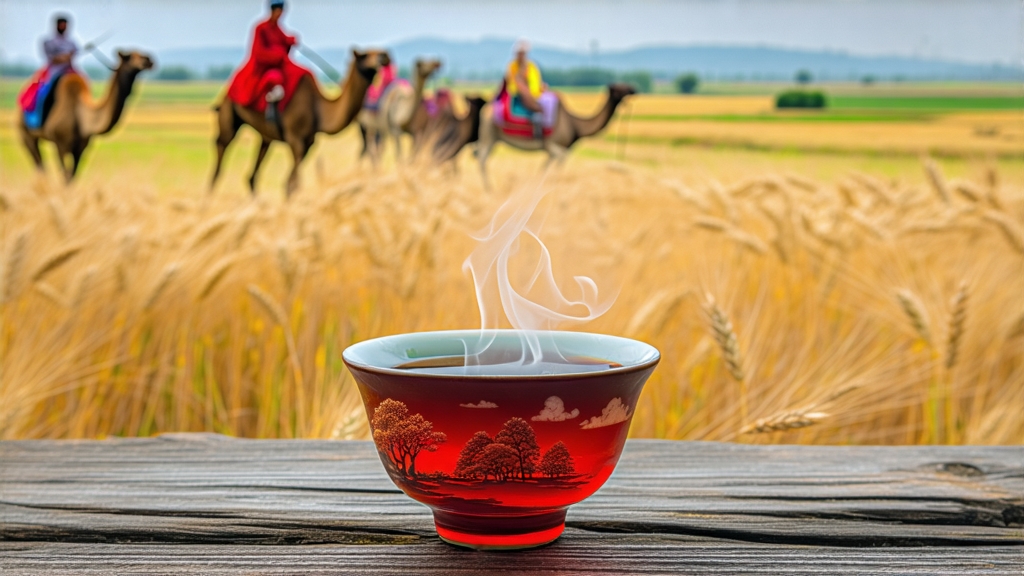
If green tea is the fresh-faced youth of Chinese tea culture, then Fu brick tea (Fú zhuān chá) is the wise elder whose stories are told in every amber sip. Compressed into solid black bricks weighing one kilogram or more, this dark tea from the small county of Jingyang in Shaanxi province once served as currency, medicine, and morale-booster for merchants who spent half a year crossing deserts. Today it is prized less for its power to quench thirst along camel tracks than for its mellow sweetness and the tiny golden “flowers” that bloom spontaneously inside the brick—visible proof of a microscopic miracle that can only happen when time, moisture, and craftsmanship align.
A Brief Caravan History
The earliest written record of Fu brick appears in the Ming dynasty (1368-1644) local gazetteer of Jingyang, but its oral history stretches back to the Song (960-1279), when government tea offices in Shaanxi began compressing coarse summer leaves into bricks to reduce freight costs on the Silk Road. Each brick was stamped with the Chinese character “Fu” (福), meaning blessing, both as a trademark and as a prayer for safe travel. By the Qing (1644-1912), annual caravans of up to 10,000 camels carried Jingyang tea westward to Kashgar, Samarkand, and eventually Lhasa, where Tibetan nomads traded horses, wool, and medicinal herbs for the dark bricks. The journey took six months; the tea arrived better than when it left, its harsh edges softened by frost at night and desert heat by day. In 1953 the Chinese government designated Jingyang as the sole official producer of Fu brick for ethnic minority regions, and the recipe—once guarded by family lineages—was standardized under the watchful eye of the China National Tea Corporation.
Leaf to Brick: The Craft of Post-Fermentation
Fu brick begins life as everyday late-season leaves from the Qinba mountain range, a region where cool mist and mineral-rich soils give the tea extra phenolic backbone. After plucking, the leaves are withered, pan-fired, and rolled in the conventional green-tea manner, but then they are piled into heaps 1.5 meters high and moistened to 28 % humidity. This “wet piling” (wò duī) stage lasts 7–10 days and is essentially a controlled composting process: thermophilic bacteria raise the core temperature to 55 °C, oxidizing catechins into theaflavins and thearubigins that paint the liquor a deep ox-blood red. When the pile emits a sweet, almost cocoa-like aroma, workers break it apart and steam the semi-fermented leaves once more before pressing them into rectangular iron molds. Here the magic ingredient—spores of Eurotium cristatum, a harmless mold present in the rafters of old Jingyang warehouses—floats down onto the warm surface. Over the next month the bricks are kept at 26 °C and 75 % relative humidity; the mold germinates, forming tiny yellow sacs the size of sesame seeds. Locals call them “golden flowers” (jīn huā); scientists call them “golden florae.” Their enzymes convert residual starch into soluble sugars and loosen cell walls so that polyphenols polymerize into even larger, smoother molecules. A well-made brick contains roughly 500,000 golden flowers per gram—so many that when you break the brick apart the cross-section glitters like flecked pyrite.
Variations on a Theme
Although Jingyang remains the spiritual home, Fu brick is now also produced in Hunan, Hubei, and Zhejiang, each region tweaking the protocol. Hunan bricks use larger-leaf cultivars from Anhua county, yielding a bolder, betel-nut aroma; Zhejiang versions are pressed lighter and age faster, developing prune and orchid notes within five years. Purists still seek the original “Jingyang Fu” marked with the eight-petal chrysanthemum seal, arguing that only the loess-plateau microclimate can coax the most intricate bouquet of camphor, jujube, and distant tobacco.
How to Unlock a Brick
Breaking a Fu brick is a ritual in itself. Insert a thin tea needle along the natural fracture lines—never pry randomly or you will create powder that clouds the liquor. Aim for 5 g of loose flakes per 120 ml of water; the golden flowers are fragile, so handle gently. Rinse once with water